ImmunoFluor™-Cyanur (PEGylated)
Description
In order to develop a rapid and straightforward coupling procedure at the PEG terminus, a method of direct coupling antibodies to the PEG terminus of liposomes was introduced by Bendas et al. In this methodology, antibodies are simply attached to the PEG terminus of liposomes, which had been endgroup-functionalized with cyanuric chloride, in mild basic conditions (pH 8.8) without prior antibody derivatizations. It has been shown that in order to obtain a stable attachment of proteins on liposome, the DSPE-PEG-cyanur was added into the liposomes to chemically conjugate with proteins to form a stable complex and minimize the denaturation of proteins.
Proteins can be covalently coupled to the liposomes via amine-reactive cyanur-groups, either directly to the vesicle surface using cyanuric chloride-activated DSPE (cyanur-DSPE) or to the distal ends of PEG-spacers using activated cyanur-PEG-PE (ammonium salt). Cyanuric chloride at the PEG terminus functions to link peptides, antibodies and other amine-containing biomolecules or nanoparticles via a nucleophilic substitution reaction under basic conditions. Antibodies or other proteins can be conjugated without any previous derivatization.
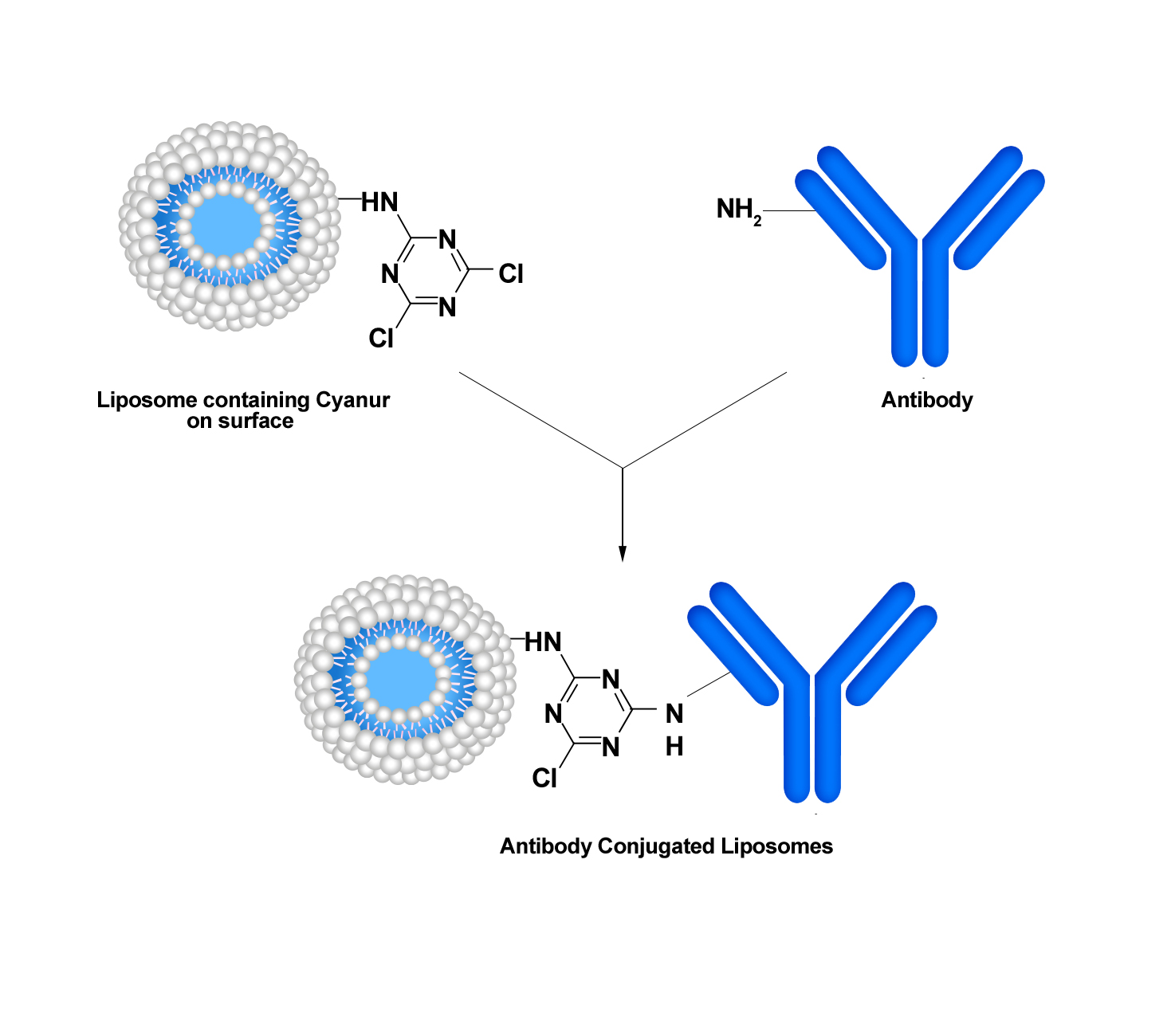
ImmunoFluor™-Cyanur is a PEGylated product. For other reactive (PEGylated and non-PEGyalated products) ImmunoFluor™ products suitable for other types conjugation methods see here.
Formulation Information
ImmunoFluor™-Cyanur (PEGylated)
| Lipid Composition | Concentration (mg/ml) | Concentration (mM) | Molar Ratio Percentage |
|---|---|---|---|
| Hydrogenated Soy PC | ~9.58 | ~12.22 | ~57 |
| Cholesterol | 3.19 | 8.25 | 38 |
| DSPE-PEG(2000) | 2.5 | 0.89 | 4 |
DSPE-PEG(2000)-Cyanur | 0.65 | 022 | 1 |
| Fluorescent Lipid (see below) | Varies based on the dye | Varies based on the dye | Varies based on the dye |
| Total | ~15.92 mg/ml | ~21.58 mM | 100 |
| Fluorescent Dye | Excitation/Emission (nm) | Molecular Structure |
|---|---|---|
| 1,1'-Dioctadecyl-3,3,3',3'-tetramethylindocarbocyanine perchlorate (DiI) | 549/565 | 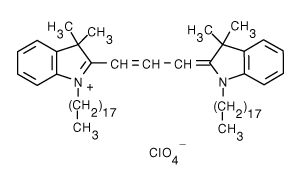 |
| 3,3'-Dilinoleyloxacarbocyanine perchlorate (DiO) | 484/501 |  |
| 1,1'-Dioctadecyl-3,3,3',3'-tetramethylindodicarbocyanine, 4-chlorobenzenesulfonate salt (DiD) | 644/665 | 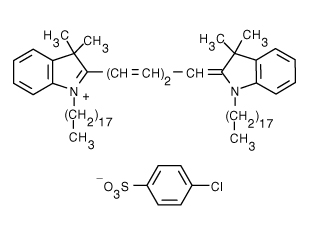 |
| 1,1'-Dioctadecyl-3,3,3',3'-tetramethylindotricarbocyanine iodide (DiR) | 750/780 | 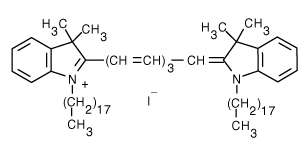 |
| 4-(4-(Dihexadecylamino)styryl)-N-methylpyridinium iodide (DiA) | 456/590 |  |
| 1,2-Distearoyl-sn-glycero-3-phosphoethanolamine-N-(7-nitro-2-1,3-benzoxadiazol-4-yl) (ammonium salt) (NBD on head group) | 460/535 |  |
| 1-Palmitoyl-2-{12-[(7-nitro-2-1,3-benzoxadiazol-4-yl)amino]dodecanoyl}-sn-glycero-3-phosphocholine (NBD on fatty acid tail) | 460/534 |  |
| 1,2-Dipalmitoyl-sn-glycero-3-phosphoethanolamine-N-(lissamine rhodamine B sulfonyl) (ammonium salt) (Rhodamine lipid) | 560/583 | 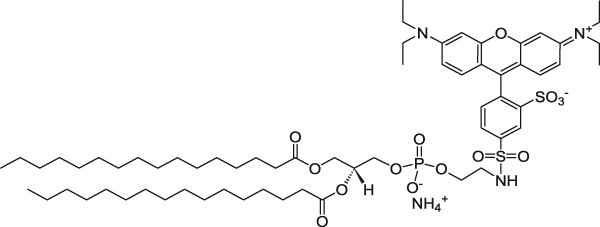 |
| 1,2-Dioleoyl-sn-glycero-3-phosphoethanolamine-N-(5-dimethylamino-1-naphthalenesulfonyl) (ammonium salt) (Dansyl lipid) | 336/513 |  |
| 1,2-Dipalmitoyl-sn-glycero-3-phosphoethanolamine-N-(1-pyrenesulfonyl) (ammonium salt) (Pyrene lipid) | 351/379 |  |
| Buffer and Liposome Size | Specification |
|---|---|
| Buffer | Borate Buffer |
| pH | 8.8 |
| Liposome Size | 100 nm |
Conjugation Protocol
Materials and Equipment
In order to conjugate your antibody, protein, peptide or ligand to ImmunoFluor™-Cyanur (PEGylated) you will need:
- Float-A-Lyzer® with a proper MWCO that easily allows the cleanup of your liposome conjugated ligand from free and non-conjugated protein/peptide/ligand. You need to make sure that the MWCO is below 1,000,000 dalton. At 1,000,000 dalton, the pore size on the dialysis membrane gets close to 100 nm and therefore your liposomes can be dialyzed out. You cannot use dialysis cassettes blindly. Please understand the technique before using either spin columns or dialysis cassettes. If you do not use the correct MWCO, you can lose your entire prep. In this case we recommend using a dialysis cassette with MWCO of 300,000 dalton.
- Borate buffer. You can either make the borate buffer or purchase it from a chemical vendor. In any case you need to make sure that the pH is adjusted to 8.8.
Preparation Method
- The total lipid concentration in ImmunoFluor™-Cyanur is 21.58 mM. 1% mol of the lipid in liposomes contains PEG-Cyanur group and only half of them are exposed to the outside of the liposomes, which is equal to 0.11 mM of reactive conjugable lipid. For 2 ml volume liposome, this is equal to 2.2×10-7 mol of PEG-Cyanur.
- Add 1:1000 molar ratio of antibody, protein, peptide or ligand to total lipid. This will be equal to 1:5 molar ratio of antibody, protein, peptide or ligand to PEG-Cyanur lipid. In a 2-ml kit, for 2.2×10-7 mol of PEG-Cyanur lipid, 4.4×10-8 mol of antibody, protein, peptide or ligand is needed.
- The conjugation must be done under mild basic condition such a borate buffer pH 8.8. Dissolve your antibody, protein, peptide or ligand in borate buffer with pH 8.8.
- Incubate ImmunoFluor™-Cynaur with antibody, protein, peptide or ligand for 16 hours at room temperature.
- Remove non-conjugated antibody, protein, peptide or ligand by dialysis. We prefer dialysis to size exclusion columns. Dialysis is a much slower process but there will be minimum loss of immunoliposomes after the prep is cleaned from non-conjugated protein/peptide/ligand. Spin columns are much faster, but you can easily lose over 50% of the liposomes on the spin column. We recommend using Float-A-Lyzer® dialysis cassette from Spectrum Labs. You need to choose a cassette with proper MWCO depending on the MW of your protein, ligand, antibody or antibody fragment. In this case we recommend using a dialysis cassette with MWCO of 300,000 dalton. NOTE: If you decide to use a dialysis cassette, you need to make sure that the MWCO is below 1,000,000 dalton. At 1,000,000 dalton the pore size on the dialysis membrane gets close to 100 nm and therefore your liposomes can be dialyzed out. You cannot use dialysis cassettes and spin columns blindly. They come in various sizes and you need to choose the correct size wisely. Dialyze the immunoliposome solution in 1 liter of PBS at pH 7.4 for 8 hours. Change the dialysis buffer with a fresh 1 liter of PBS and let is dialyze for another 8 hours. After this step, your cleaned up immunoliposome is ready to be used.
Liposome Particle Calculator
ImmunoFluor™ liposomes are unilamellar and sized to 100 nm. The molar concentration of liposome is 21.58 mM. By having liposome diameter (nm) and lipid concentration (µM), you can calculate the total number of the lipids in one liposome and the number of the liposomes in one milliliter of the liposome solution. To use the calculator click here.
Technical Notes
- Tris buffer should never be used in any step of the process since it contains amine.
- Cyanuric chloride is considered as a sensory respiratory irritant. However, despite the name of the cyanur-modified liposomes, they have not shown any sign of acute, chronic or genotoxicity.
- Cyanur groups are amine-reactive, however, some random attachments of the antibodies can be expected since cyanuric chloride can react with a wide range of nucleophilic functionalities, such as alcohols and thiols. This may interfere with the binding of the antibody to the liposome, and therefore, the binding affinity would change.
- Size exclusion spin columns such as Sepharose® CL-4B can be used instead of Float-A-Lyzer® dialysis cassette. However, a very large amount of liposomes will stick to the column during the cleanup process and therefore we strongly suggest using dialysis than size exclusive beads.
- If you are using a ligand or peptide that is hydrophobic, it is recommended to solubilize it in DMSO or DMF and then add the buffer to it. It is recommended not to use more than 5% volume of DMSO or DMF in the solution. DMF and DMSO are both compatible with liposomes and they are also miscible in water. Other organic solvent such as ethanol and chloroform are not compatible with liposomes and will cause the liposomes to lyse. If you end up using DMSO or DMF then after the conjugation reaction is done, you need to remove DMSO and DMF from the liposomes. In order to do that you need to use a dialysis cassette that is made from REGENERATED CELLULOSE MEMBRANE. NOTE: Not all membranes are compatible with DMF and DMSO. We recommend using a Slide-A-Lyzer™ MINI Dialysis Device with MWCO of 2K made from regenerated cellulose membrane manufactured by ThermoFisher. After DMSO or DMF is removed, you can use Float-A-Lyzer® dialysis device for the final step of cleaning up the prep.
- Liposomes should be kept at 4°C and NEVER be frozen.
Database
Direct link to the database page for easy navigation: Immunoliposomes Conjugation Database
Appearance
ImmunoFluor™-Cyanur formulation is colored and the color depends on the type of the fluorescent dye that is used (see SDS for appearance). Usually due to the small size of liposomes no settling will occur in the bottom of the vial. The liposomes are packaged in an amber vial.
Ordering/Shipping Information
- All liposome based formulations are shipped on blue ice at 4°C in insulated packages using overnight shipping or international express shipping.
- Liposomes should NEVER be frozen. Ice crystals that form in the lipid membrane can rupture the membrane, change the size of the liposomes and cause the encapsulated drug to leak out. Liposomes in liquid form should always be kept in the refrigerator.
- Clients who order from outside of the United States of America are responsible for their government import taxes and customs paperwork. Encapsula NanoSciences is NOT responsible for importation fees to countries outside of the United States of America.
- We strongly encourage the clients in Japan, Korea, Taiwan and China to order via a distributor. Tough customs clearance regulations in these countries will cause delay in custom clearance of these perishable formulations if ordered directly through us. Distributors can easily clear the packages from customs. To see the list of the distributors click here.
- Clients ordering from universities and research institutes in Australia should keep in mind that the liposome formulations are made from synthetic material and the formulations do not require a “permit to import quarantine material”. Liposomes are NOT biological products.
- If you would like your institute’s FedEx or DHL account to be charged for shipping, then please provide the account number at the time of ordering.
- Encapsula NanoSciences has no control over delays due to inclement weather or customs clearance delays. You will receive a FedEx or DHL tracking number once your order is confirmed. Contact FedEx or DHL in advance and make sure that the paperwork for customs is done on time. All subsequent shipping inquiries should be directed to Federal Express or DHL.
Storage and Shelf Life
Storage
ImmunoFluor™ products should always be stored at in the dark at 4°C, except when brought to room temperature for brief periods prior to animal dosing. DO NOT FREEZE. If the suspension is frozen, the encapsulated drug can be released from the liposomes thus limiting its effectiveness. In addition, the size of the liposomes will also change upon freezing and thawing.
Shelf Life
ImmunoFluor™-Cyanur is made on daily basis. The batch that is shipped is manufactured on the same day. It is advised to use the products within 2 months of the manufacturing date.











